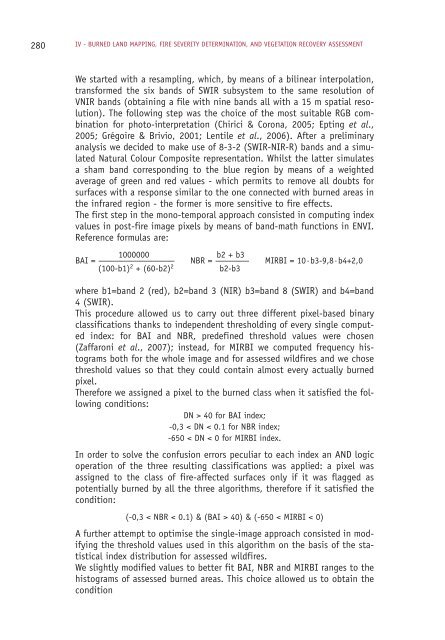7th Workshop on Forest Fire Management - EARSeL, European ...
7th Workshop on Forest Fire Management - EARSeL, European ...
7th Workshop on Forest Fire Management - EARSeL, European ...
You also want an ePaper? Increase the reach of your titles
YUMPU automatically turns print PDFs into web optimized ePapers that Google loves.
280<br />
IV - BURNED LAND MAPPING, FIRE SEVERITY DETERMINATION, AND VEGETATION RECOVERY ASSESSMENT<br />
We started with a resampling, which, by means of a bilinear interpolati<strong>on</strong>,<br />
transformed the six bands of SWIR subsystem to the same resoluti<strong>on</strong> of<br />
VNIR bands (obtaining a file with nine bands all with a 15 m spatial resoluti<strong>on</strong>).<br />
The following step was the choice of the most suitable RGB combinati<strong>on</strong><br />
for photo-interpretati<strong>on</strong> (Chirici & Cor<strong>on</strong>a, 2005; Epting et al.,<br />
2005; Grégoire & Brivio, 2001; Lentile et al., 2006). After a preliminary<br />
analysis we decided to make use of 8-3-2 (SWIR-NIR-R) bands and a simulated<br />
Natural Colour Composite representati<strong>on</strong>. Whilst the latter simulates<br />
a sham band corresp<strong>on</strong>ding to the blue regi<strong>on</strong> by means of a weighted<br />
average of green and red values - which permits to remove all doubts for<br />
surfaces with a resp<strong>on</strong>se similar to the <strong>on</strong>e c<strong>on</strong>nected with burned areas in<br />
the infrared regi<strong>on</strong> - the former is more sensitive to fire effects.<br />
The first step in the m<strong>on</strong>o-temporal approach c<strong>on</strong>sisted in computing index<br />
values in post-fire image pixels by means of band-math functi<strong>on</strong>s in ENVI.<br />
Reference formulas are:<br />
1000000 b2 + b3<br />
BAI = ---------------------------------- NBR = --------------- MIRBI = 10·b3-9,8·b4+2,0<br />
(100-b1) 2 + (60-b2) 2 b2-b3<br />
where b1=band 2 (red), b2=band 3 (NIR) b3=band 8 (SWIR) and b4=band<br />
4 (SWIR).<br />
This procedure allowed us to carry out three different pixel-based binary<br />
classificati<strong>on</strong>s thanks to independent thresholding of every single computed<br />
index: for BAI and NBR, predefined threshold values were chosen<br />
(Zaffar<strong>on</strong>i et al., 2007); instead, for MIRBI we computed frequency histograms<br />
both for the whole image and for assessed wildfires and we chose<br />
threshold values so that they could c<strong>on</strong>tain almost every actually burned<br />
pixel.<br />
Therefore we assigned a pixel to the burned class when it satisfied the following<br />
c<strong>on</strong>diti<strong>on</strong>s:<br />
DN > 40 for BAI index;<br />
-0,3 < DN < 0.1 for NBR index;<br />
-650 < DN < 0 for MIRBI index.<br />
In order to solve the c<strong>on</strong>fusi<strong>on</strong> errors peculiar to each index an AND logic<br />
operati<strong>on</strong> of the three resulting classificati<strong>on</strong>s was applied: a pixel was<br />
assigned to the class of fire-affected surfaces <strong>on</strong>ly if it was flagged as<br />
potentially burned by all the three algorithms, therefore if it satisfied the<br />
c<strong>on</strong>diti<strong>on</strong>:<br />
(-0,3 < NBR < 0.1) & (BAI > 40) & (-650 < MIRBI < 0)<br />
A further attempt to optimise the single-image approach c<strong>on</strong>sisted in modifying<br />
the threshold values used in this algorithm <strong>on</strong> the basis of the statistical<br />
index distributi<strong>on</strong> for assessed wildfires.<br />
We slightly modified values to better fit BAI, NBR and MIRBI ranges to the<br />
histograms of assessed burned areas. This choice allowed us to obtain the<br />
c<strong>on</strong>diti<strong>on</strong>
















